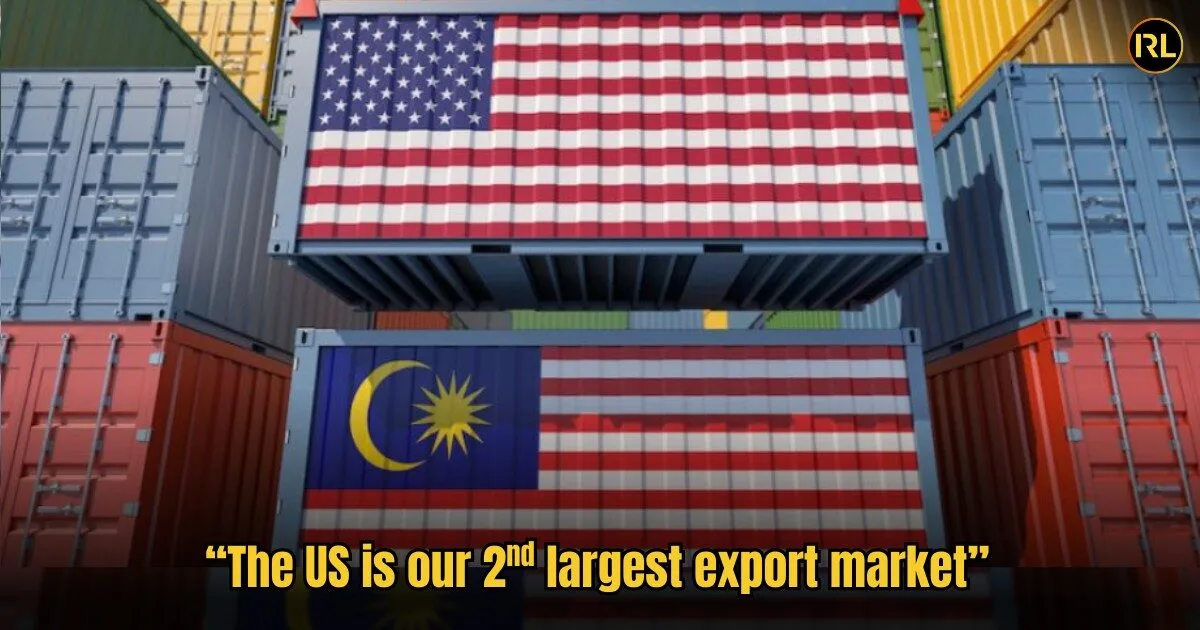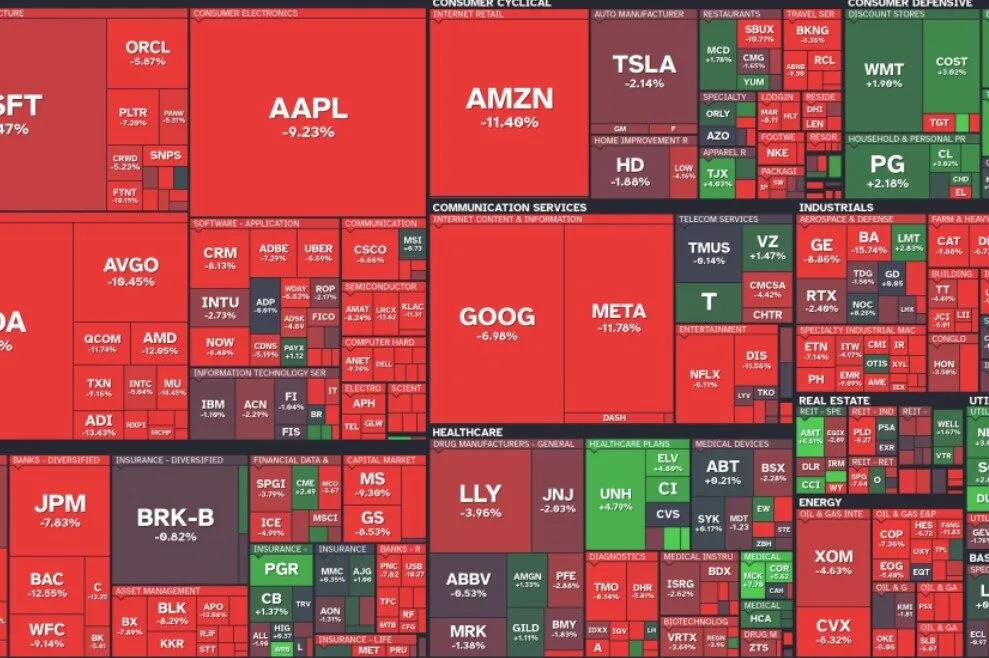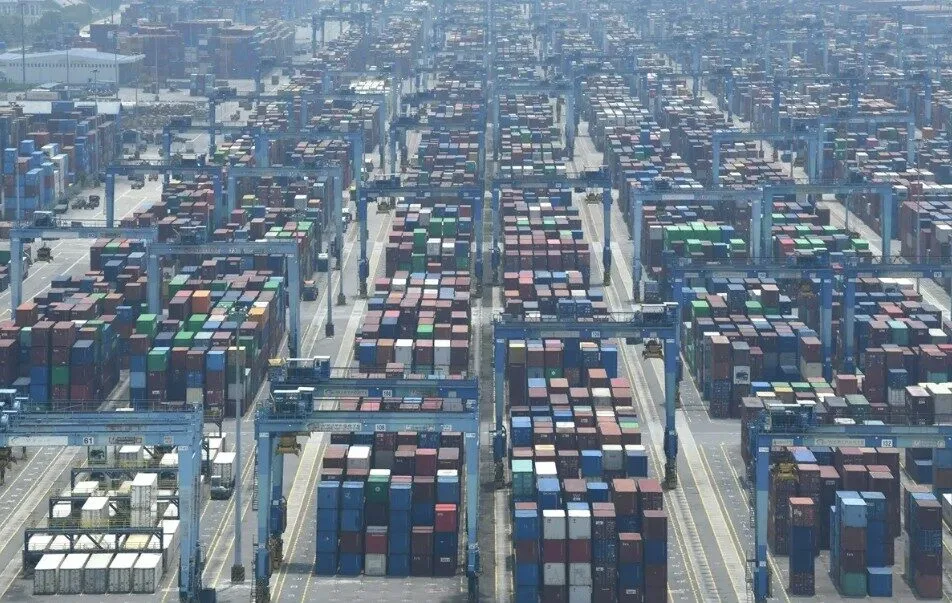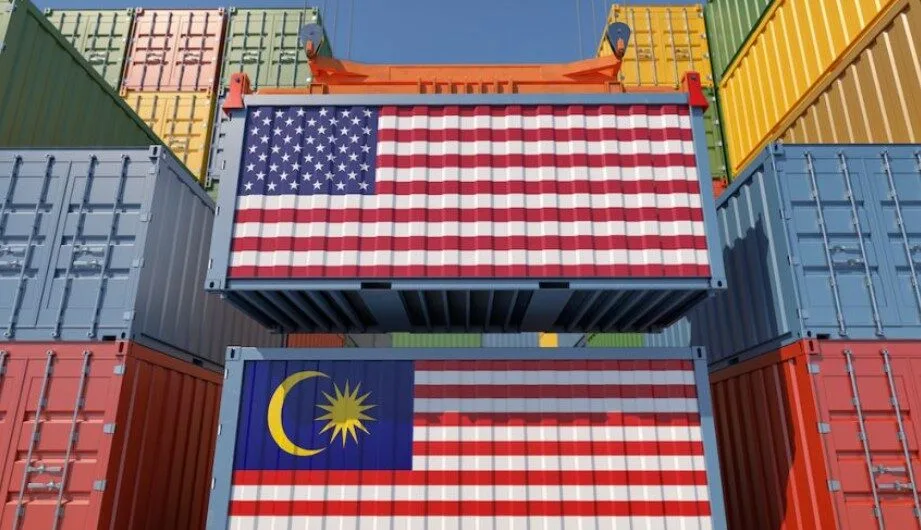
This thinkpiece analyses the impact of Trump’s recent tariffs on the global economy, and how it will affect Malaysia’s GDP moving forward in 2025.
At first glance, US President Donald Trump’s recent tariff moves look like the actions of a madman trying to crash the global economy.
On Friday morning, Trump shared a video on Truth Social that claimed he was “Crashing the stock market…but he’s doing it on purpose,” a statement that sent ripples across financial circles.
China was slapped with a 34% tariff which it said on Friday it would reciprocate. Meanwhile, the UK received a comparably more lenient 10% levy, while EU countries face a 20% import tax to the US.

A screen from the finviz financial news site shows the one-day performance of the S&P 500.
The immediate effects were severe: The S&P 500, which saw stellar growth in 2023 and 2024, is down over 8% in 2025. Gold is hovering near record highs, and the US dollar just clocked its worst week in a month.
To the average global observer, this looks like economic self-sabotage. Even Warren Buffett called Trump’s policy an “act of war,” warning that tariffs function as hidden taxes on consumers.
The ripple effects are real: US retirement savings are plummeting, investors are jittery, and the threat of a global recession looms large.
But according to Malaysian political commentator Lim Sian See, this “insanity” may actually be a radical, calculated strategy designed to reshape the US economy and rewrite the rules of global trade.
Understanding Protectionism
Before we dismiss Trump’s moves as populist theater, let’s unpack the economics.
Protectionism, the economic philosophy underpinning tariffs, is the practice of shielding a country’s domestic industries from foreign competition by taxing imports. The idea is to make foreign goods more expensive, thereby encouraging consumers to “buy local” and support home-grown businesses.
Michael Farr, CEO of Farr, Miller & Washington, explains: “Protectionism feels good, but it’s expensive.” While it can stimulate domestic industries in the long run, the short-term costs are undeniable—higher consumer prices, volatile markets, and international backlash.
In Trump’s case, the tariffs function almost like a targeted consumption tax—not unlike Malaysia’s SST or GST. But here’s the twist: they’re only applied to imported goods, and vary based on their country of origin.
So, who are the consumers who buy the most imports? High-income Americans, who are the biggest consumers of luxury foreign goods. In theory, Trump’s tariff strategy should tax the wealthy more than the poor. And if the US government redistributes that income, the wealth should flow from the top earners to the average citizen.
Playing Hardball: The Negotiation Angle

Historically, tariffs have been used as blunt weapons of negotiation. Countries that want continued access to the lucrative US market would now have to play by Trump’s rules, such as lowering tariffs on US goods, removing non-tariff trade barriers, and investing heavily in the US economy.
This strategy would force other nations into one-on-one negotiations where the US holds all the cards. One example of this is when Malaysia agreed to purchase 60 Boeing planes.
One private investor that In Real Life spoke to believes Trump is bluffing: “I think he just wants people to come to the negotiating table. He’ll probably re-announce more moderate tariffs in a couple of days or weeks.”
The Global Fallout
Of course, this kind of economic aggression doesn’t come without collateral damage.
The US bank J.P. Morgan has raised America’s global recession risk to 60%. Bank of America warns that prolonged negotiations could stall economic activity and spark worldwide boycotts of US goods. And recession means higher unemployment: the US jobless rate is projected to climb to 5.3%, from 4.2% in March.
In the short term, ordinary Americans suffer. Prices have risen, markets have started to panic, and foreign trade partners will feel the negative effects from disrupted supply chains.
Lim Sian See that this pain could be part of a longer-term gain. “Trump’s tariffs seem insane, but there’s logic behind it,” he said in a Facebook post. If the US uses tariff revenue to support its citizens and simultaneously rebuilds its manufacturing capacity, it could reduce dependence on imports entirely.
Why Malaysia Should Pay Attention

So why should we in Malaysia care?
Because our economy—like many in ASEAN—is heavily reliant on exports, particularly to the United States. When the world’s largest consumer market rewrites the rules of engagement, it affects everyone.
The US is currently Malaysia’s second-largest export market, contributing 13.2% to the country’s total exports valued at RM1.51 trillion, according to data from the Department of Statistics Malaysia, compiled by the Malaysia External Trade Development Corporation. For comparison, Singapore is our largest trading partner at 15.3%, with China coming in third at 12.4%.
BIMB Securities analyst Maliana Shaharudin said in The Edge that this could be a positive outcome for us, as MNCs may potentially use Malaysia as a re-export hub or a more cost-effective alternative to existing trade flows.
But these are short-term gains. In a world where tariffs are the norm and trade wars become standard policy, smaller economies like ours may be forced to choose sides—or face isolation.
Lim Sian See notes that while Trump’s strategy could fail, the only way to make that happen would be for the entire world to unite in resistance.
“In reality, that won’t happen,” he says. “The EU will not ally with China, ASEAN is split up, many developing countries are too dependent on American markets, and MNCs worldwide will want access to 300 million high-income US consumers.”
So instead of global resistance, what we’re likely to see is piecemeal surrender: Countries cutting separate deals with Washington, giving Trump and America the upper hand.
Is Trump Crazy, or Just Cunning?
So, what do you think? Is Trump playing economic chess while the rest of the world plays checkers? Or is he rolling the dice with the global economy?
What do you think?
Share your thoughts on our Facebook page and you may be featured on In Real Life Malaysia.
Read also:
Why Malaysians Are Complaining About PuTERA35, Anwar’s Plan to Uplift Bumiputera by 2035
Why Malaysians Are Complaining About PuTERA35, Anwar’s Plan to Uplift Bumiputera by 2035
More from Economy
“We Live Paycheck to Paycheck,” M’sians Share The Silent Struggle of M40 Income Earners
This story is about the silent struggles that those Malaysians in the middle class, the M40, face on a daily …














